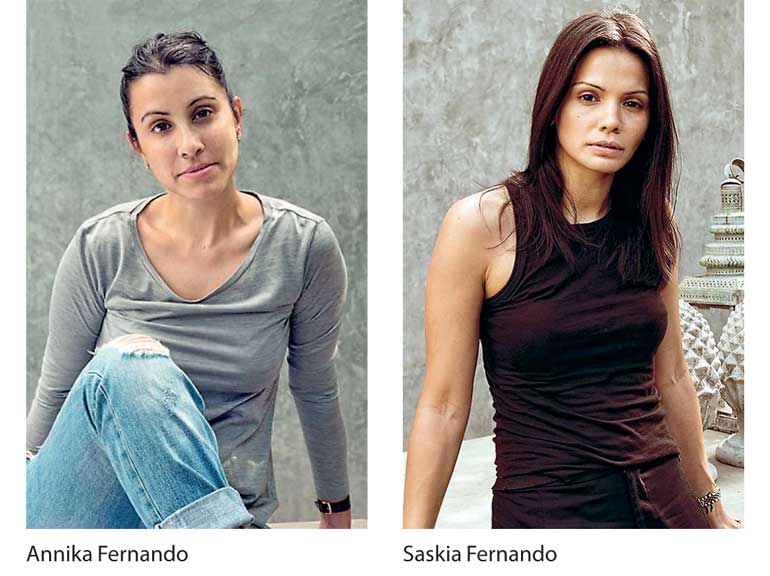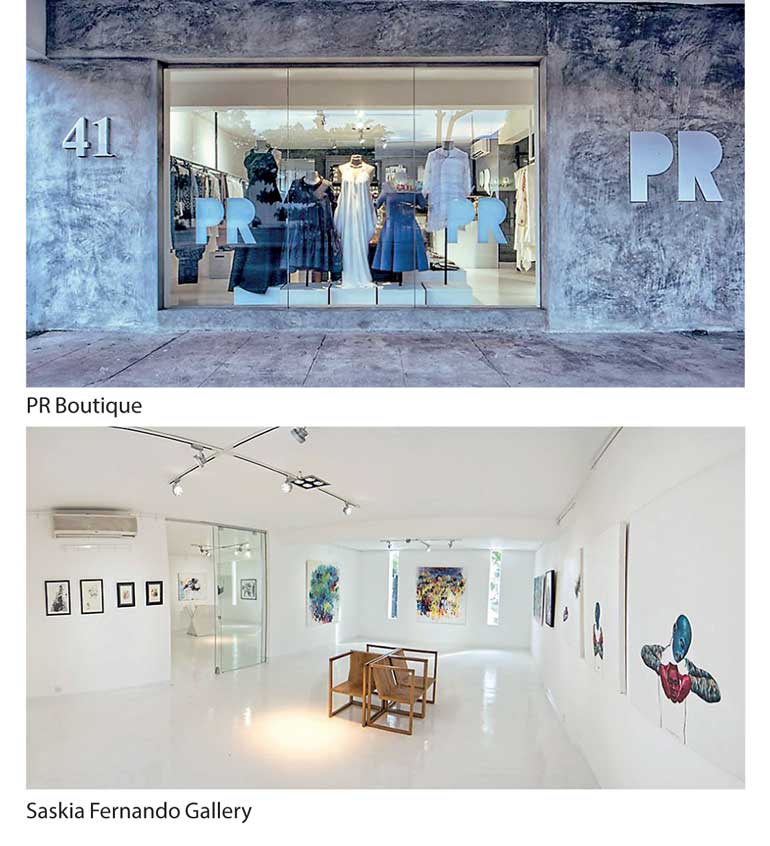Sunday Apr 20, 2025
Sunday Apr 20, 2025
Friday, 21 April 2017 00:00 - - {{hitsCtrl.values.hits}}

www.vervemagazine.in: Number 41 Horton Place is what many refer to as Colombo’s creative nerve centre, with its unmistakably stark and minimalist facade. The lower level of the building houses PR, the capital’s hottest multi-label store, run by Annika Fernando, while the mezzanine is occupied by her sister, Saskia Fernando’s eponymous gallery. To say that the sisters have played an important role in putting the island-nation’s fashion, design and art on the map would not be doing them justice.
They are, after all, the gorgeous daughters of the legendary Udayshanth Fernando, who defined the modern Sri Lankan aesthetic with his iconic home store Paradise Road, as well as Colombo’s most luxurious boutique hotel, Tintagel. The three-decade-old family-run empire also includes the uber-chic Gallery Cafe in Colombo, designed by Geoffrey Bawa, as well as another Bawa masterpiece, Villa Bentota.
On a balmy afternoon, I step into the store-gallery, where the sisters share an office. Seated at two ends of a long desk, they run their respective companies. Disarmingly charming and stylish in their own way, Annika and Saskia welcome me into their shared space. My first question is about siblings working in such close proximity. With creative energies raging, do their wires ever get crossed? Saskia responds, “Definitely. But we also have very clearly defined activities. In the art space, I just do my own thing, but with my jewellery brand, Annika’s the person I turn to; I create the pieces and she does the rest.” On living in a family of established creative people, Annika says, “My family loves to share opinions, so one gets them even if one doesn’t ask.” Saskia adds, “I do work with her on some of her projects, but, by and large, we are our own bosses. My dad does come in and give me his thoughts on what he likes and doesn’t like. But I don’t necessarily consult him. We’re all strong and confident of what we’re doing.”
Thus begins a freewheeling chat about their work in fashion, art and design
In the burgeoning local fashion space, Annika plays an important role. Her boutique PR, a word-play on her family-run store Paradise Road, is a showcase of the country’s finest designers, both up-and-coming and established. In addition, the store, which opened in 2013, also stocks her own label Maus, along with a selection of jewellery and natural bath products. The Sri Lankan industry is small, and PR fills in a lacuna by providing retail opportunities for local brands.
Sustainable fashion happens to be a leitmotif of PR’s offering, especially with Sri Lanka being one of the frontrunners in that respect. “It is just something that is taken for granted. Here, almost all our labels are sustainable. I think, around the world, it is a great story for products, but here, most of them are, in some way ethical and green,” she says. Annika’s own sensibilities manifest themselves in the products on display – minimalist, earthy, even androgynous, devoid of embellishment. This is explained by the fact that Annika, a mother of one, does all the visual merchandising herself and chooses every single product in the store.
It would seem that PR’s strength lies in Annika’s vision and unfailing eye. “I only choose to showcase brands if they have a strong DNA and are consistent. A lot of young labels shift and are still finding themselves.”
Interestingly, a couple of Indian brands have also made the cut to PR’s repertoire – Rajesh Pratap Singh, Abraham & Thakore and Payal Pratap to name a few. “I love Urvashi Kaur’s work, and I am in talks with her right now,” says Annika. “While I do love Indian designers, you have to realise that they are becoming increasingly expensive so I’m now looking at a lot of smaller brands. I just signed on a label called Ritesh Kumar. I’ve never met him, but he sent me a look book; I loved the stuff so I ordered a few pieces.”
How, then, does she strike the right balance to ensure that they appeal to the sensibilities of her clientele? “India and Sri Lanka are very different. What works in India does not work here. We’re far less embellished, we don’t have as many events and our weddings aren’t so elaborate. The wedding market in India plays such a big role. We don’t have that here. I fell in love with the Sabyasachi store when I was in Mumbai, but there was nothing I could buy.”
Not only is she helping to promote Indian labels through her store, she is working hard to bring Sri Lankan designers across the border as well. Her recent collaboration with Bungalow 8 in Mumbai resulted in a pop-up where she brought in six designers, giving them a larger platform.
Looking back at her family background, Annika maintains that she was never pushed to be in the creative field. “When I went to university, my father did not want me to study design. However, I remember being very involved in the interiors of the house, or working in the store.” She cultivated a taste for retail as a girl and was always playing shop, creating special packaging and labels for the goods in her room. She went on to start an interior design consultancy, where she practised for a few years. “While PR was being set up, I decided to launch my label Maus, as well. We have such a great garment manufacturing infrastructure here so it makes it easier. Today, we do two or three collections a year and now we even have a line of organic swimwear.” Maus collections are interestingly named ‘summer, monsoon and fete’ with no reference to fall-winter whatsoever.
What’s the future looking like for the entrepreneur, who is a self-confessed control freak, so much so that she is “taking baby steps at even delegating social media posts”? She says, “If the right space comes up, maybe another store. I’d like to take my time and let things happen organically. The next step is PR’s online shop. Till now, orders would come on WhatsApp. That will change soon. My main aim is to constantly work with new designers and to continuously reinvent my retail space.”
“I climb up one flight of stairs to Saskia Fernando Gallery. Over the past few years, Saskia has earned a reputation as one of the country’s most respected gallerists and a regular on the international art circuit. Her venture represents 22 artists ‘who are Sri Lankan and/or living in Sri Lanka’. There has to be some local connect.”
A case in point is a New Zealand surfer-artist, who has been visiting since the ‘80s. “While it is hard to define who is Sri Lankan,” she says, “you have to be quite broad with your definition. That said, all the work needs to connect in some way. I try to keep it as diverse and contemporary as I can.”
Just like her sister, Saskia’s career wasn’t necessarily careening towards art. She studied hospitality and commerce but says that “art was something I always wanted to do.” While her sister moved to retail and design, Saskia decided to pursue her own calling. “Anyone will tell you that to run a gallery, you have to be very passionate about it,” she says. Following a “boring and uninspiring” hotel internship in London, she returned to Colombo and used an empty space that her father offered her. She slowly began to represent artists and the Saskia Fernando Gallery was thus founded in 2009.
From being a one-woman show, she now has a team of seven and a portfolio of more than 2,000 works. Today, she also caters to a niche of Indian clients who collect contemporary Sri Lankan works. “They love it because it is emerging and less overwhelming.” As she says this, she points out to a piece by a young self-taught artist, depicting the life of people in the tea country and their strife. Is her gallery a tool for social messages, then? “A lot of my artists do push social causes. At the same time, there are many who don’t. I like that balance because I don’t want to be defined as a gallery that only talks about political issues.”
In addition to her gallery, Saskia’s jewellery label Papillon du Thé is stocked at PR (and more recently, at Bungalow 8 in Mumbai). Saskia would make jewellery for her mother and sister, till one day, Annika gave her the idea to start her own line. “To create my handmade jewellery, I work with a lot of small workshops. They are one-of-a-kind pieces that make it more personal,” she says.
Today, Saskia effortlessly juggles her dual roles, playing out both with equal aplomb. As she bullishly supports the contemporary art scene in Sri Lanka, she remains highly optimistic. “We are very much on the map now. Most of our artists have strong references to our culture. We may have a lot of diversity, but you will always find that strong connection to the country. And the younger people are leading the way.”
Discover Kapruka, the leading online shopping platform in Sri Lanka, where you can conveniently send Gifts and Flowers to your loved ones for any event including Valentine ’s Day. Explore a wide range of popular Shopping Categories on Kapruka, including Toys, Groceries, Electronics, Birthday Cakes, Fruits, Chocolates, Flower Bouquets, Clothing, Watches, Lingerie, Gift Sets and Jewellery. Also if you’re interested in selling with Kapruka, Partner Central by Kapruka is the best solution to start with. Moreover, through Kapruka Global Shop, you can also enjoy the convenience of purchasing products from renowned platforms like Amazon and eBay and have them delivered to Sri Lanka.
Discover Kapruka, the leading online shopping platform in Sri Lanka, where you can conveniently send Gifts and Flowers to your loved ones for any event including Valentine ’s Day. Explore a wide range of popular Shopping Categories on Kapruka, including Toys, Groceries, Electronics, Birthday Cakes, Fruits, Chocolates, Flower Bouquets, Clothing, Watches, Lingerie, Gift Sets and Jewellery. Also if you’re interested in selling with Kapruka, Partner Central by Kapruka is the best solution to start with. Moreover, through Kapruka Global Shop, you can also enjoy the convenience of purchasing products from renowned platforms like Amazon and eBay and have them delivered to Sri Lanka.